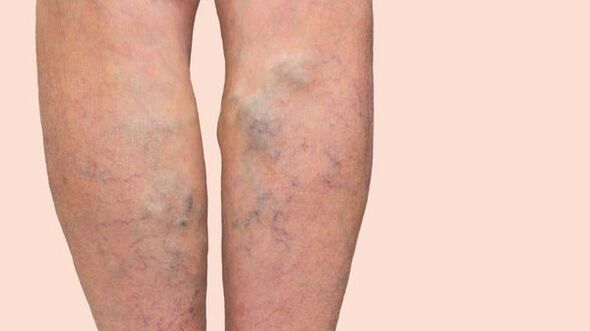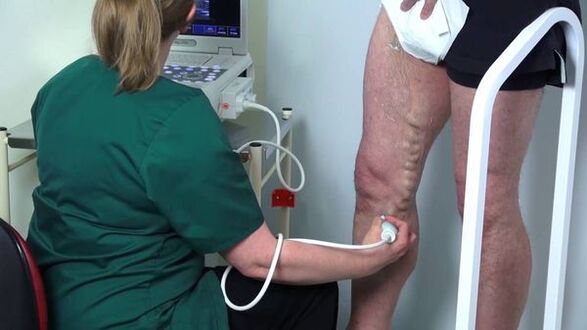Varicose veins are a disease in which the veins in the legs in particular are very sore. What to do if symptoms appear, how to treat varicose veins and what factors are the basis for the development of the diseaseAwareness of these problems will help avoid the negative consequences of the disease.
General information about varicose veins
Almost every fifth person in the total world population is carrier of varicose veins. The main threat to the disease is the fact that its symptoms cannot be noticed immediately, which is why timely treatment is delayed and the disease leads to complications.
The full medical name for such a disease is varicose veins. From the name it can be seen that in the presence of a disease, peripheral veins on the limbs of the human body increase in size, giving them a puffy and unhealthy appearance.

With varicose veins, knots, cobwebs, clusters, and other non-standard interweaving of veins can appear on the skin. Their color becomes deeper, edema and pain appear. Due to the appearance of lumps, blood cannot flow stably through the veins, blood clots appear, as a result of which the veins are exposed to high pressure.
When a certain pressure indicator is reached, the blood in the veins is pushed outwards in the case of a thrombosis and the vessel walls are stretched. The first characteristic symptoms of varicose veins appear, such as a noticeable intertwining of the veins, an expansion in volume and a deep blue tint.
Most often, varicose veins cover the surface of the legs, so people suffering from such a disease complain of pain in the leg veins. Treatment of varicose veins should be immediate and carried out under the supervision of an experienced doctor. When the first symptoms appear, see a therapist.
causes
The main cause of varicose veins is a disruption of stable blood flow. It is the stagnation of blood in the veins that leads to the pressure being placed on them. Therefore, the main factors that affect the development of varicose veins include:
- Genetic predisposition. If both parents had varicose veins, the chance of their child developing the disease can be as high as 70%. The first symptoms of the disease appear at a young age, and the development of the disease can be avoided with medical care.
- Increased physical activity. Standing on your feet for long periods of time can strain your blood vessels. Therefore, varicose veins are often found in professional athletes and people who are exposed to hard physical performance work.
- Lack of physical activity. With complete freedom of movement of the blood vessels, blood stagnates. The elderly, as well as office workers who lead a sedentary or sedentary lifestyle, can suffer from varicose veins.
- Hormonal imbalance. Dysfunction of the hormonal or endocrine system of the human body can have various consequences. For example, female representatives are confronted with congestion of blood in the vessels. Hormonal disorders can occur during puberty, pregnancy, breastfeeding, during the menopause as well as through private stressful situations and nervous disorders. In such phases, the woman's body is not dominated by estrogen, but by the luteal body hormone, which has a relaxing effect on the muscles.
- Mechanical effect on the veins. The contraction of peripheral veins on the surface of the extremities can also affect the occurrence of blood congestion. Close-fitting clothing, for example, has such an effect.
- Alcohol abuse. Alcohol contains substances toxic and poisonous to the body, and it also increases blood pressure. Toxins and pressure cause the walls of the blood vessels to lose strength and resilience.
- Obesity. Excessive food intake leads to rapid weight gain, as a result of which the limbs may not tolerate the stress placed on them.
Usually, when the veins on the legs hurt, varicose veins are the cause of painful sensations. You should pay attention to the factors that can affect the development of the disease and revise the lifestyle.
Symptoms
Before starting treatment for varicose veins, it is necessary to make sure that the veins are very sore precisely because of the appearance of such a disease. The disease is not asymptomatic, the main thing is to pay attention to deviations from the norm in the work of the body. The following manifestations speak of varicose veins:
- Pain in the legs. The pressure that the blood puts on the vessel walls leads to painful and uncomfortable sensations in the lower extremities. Then the vein hurts, you may get an uncomfortable burning sensation and a feeling of heaviness in your legs.
- Swelling. Swelling on the surface of the legs can occur towards the end of the day, when the limbs are experiencing a peak of tension. Swelling affects not only the main part of the legs, but also the feet, ankles, and the knee flexion area.
- Cramps. Spasmodic muscle contractions with varicose veins usually occur at night. They may be accompanied by a nervous tic and convulsive twitching.
- Expansion of the veins. As mentioned earlier, veins with varicose veins take on a completely different look. They're puffy, tortuous, and deep blue. Large saphenous veins indicate the presence of a thrombosis.
- Discoloration of the skin. Due to the fact that during the disease there is a congestion of blood in the vessels, the skin under the peripheral veins can darken and dull its shade.
- Trophic ulcers. Due to a violation of the blood supply to the skin, defects appear that do not heal for a long time.
The main symptoms of varicose veins are fever and general weakness of the body.
Once you start treating the disease, it can progress to the next level. With the rapid development of varicose veins of the lower extremities, the following symptoms may appear:
- Hardening of the skin;
- dark spots;
- Loss of moisture in the skin, violation of its diet;
- Bleeding from rupture of the nodes.
If any of these symptoms occur, you should see a doctor immediately and start treatment.

Treatment methods
If the veins on the legs just hurt from varicose veins, the specialist will prescribe a whole range of measures to get rid of the disease. The most common treatments for varicose veins include:
- medicinal preparations;
- Home remedies;
- Gymnastics;
- Massage;
- Compresses and bandaged affected areas;
- special diet.
Treatment is most effective when the patient agrees to a comprehensive and nonselective approach.
Medication
Medicines for the treatment of varicose veins can be divided into 4 groups:
- external use;
- for oral administration;
- to eliminate symptoms;
- to treat underlying causes;
- Operating methods.
In the fight against the disease, doctors prescribe blood-thinning drugs, pain relievers and anti-inflammatory drugs, a vitamin complex, etc. Oral drugs can be given orally or by injection.
Any drug should be used only under the supervision of the attending physician, observing the instructions for use and the duration of treatment.
Home remedies
Folk remedies for the treatment of varicose veins should complement a number of measures aimed at eliminating the disease. You can use them at home.
Common folk methods include:
- medicinal baths;
- Compresses;
- Decoctions of herbs.
Baths for the effective treatment of varicose veins are recommended 3-4 times a week. The water should be diluted with special sea salt for baths or specially prepared herbs. For example, you can use the following recipe:
- Fill the bathtub with warm water.
- Dissolve dry leaves of medicinal herbs in water.
- Take a bath for 20-25 minutes.
Chamomile, St. John's wort, oak bark and plantain leaves, which can be purchased in any pharmacy in the city for a small fee, are suitable raw materials for baths. It is possible to take such baths for prophylactic purposes, as they help cleanse the vessels of toxins, and also stabilize blood flow.
Compresses and lotions can be made with pharmacy herbal and essential oils, aloe juice, or honey. To do this, you need to apply one of the listed components to the areas affected by varicose veins, and then wrap the area of application with an elastic bandage. You need to change such compresses twice a day every 2-3 hours.
You can prevent the development of the disease in a popular way by consuming decoctions of medicinal herbs inside. Raw materials from the following herbs are suitable for the preparation of broths:
- Hawthorn;
- Chamomile;
- Hop cones;
- Plantain;
- Johannis herbs;
- Licorice root;
- Angelica root.
You should consult with your doctor about alternative methods in advance. It is possible that some components cannot be used due to allergic reactions.
gymnastics
One of the reasons for the development of varicose veins is inactivity, which leads to stagnation of blood in the vessels. Therefore, people who are forced to lead a computer lifestyle should regularly do gym exercises at home. E. g . :
20-25 times:
- Sit in a chair
- Squeeze your legs together
- Tense your muscles
- Lower your feet down to your toes and then down to your heels
20-25 times:
- Lean against the wall with both hands
- Climb on tiptoe
- Come on your heels
15-20 times:
- Sit down
- Stand on tiptoe while sitting
- Come on your heels
15 times on each leg:
- Sit down
- Raise your right leg parallel to the floor for 7 seconds
- Lower
- Do the same with your left leg.
massage
Varicose vein massage can be done independently at home. You need a special nourishing cream or oil. Sea buckthorn is perfect. It should be rubbed into the problem areas of the legs in circular movements for five minutes a day. This procedure also increases the elasticity of the skin and nourishes it with moisture.
diet
The diet for varicose veins implies limiting consumption or completely avoiding the following foods:
- Broths;
- Marinades;
- salty, smoked, sweet foods fried in oil;
- Coffee and derived drinks;
- Alcohol and tobacco products.
It is worth diversifying the diet with foods that have a positive effect on strengthening blood vessel walls:
- fresh fruits and vegetables;
- Nuts;
- Fish products, seafood;
- Greens;
- fermented milk products.
Surgical methods
There is a treatment for varicose veins and surgery. However, it is used in extremely advanced cases. The operations consist of tying off the veins of the esophagus and stomach by imposing an anastomosis or placing a stent in the duct between the liver and portal veins.
To avoid varicose veins, it is worth resting your legs and taking preventive measures at home. Effective treatment of existing varicose veins consists in timely and complex treatment under the guidance of a specialist.
Which doctor should you contact?
Treatment is carried out by a phlebologist, a vascular surgeon.

























